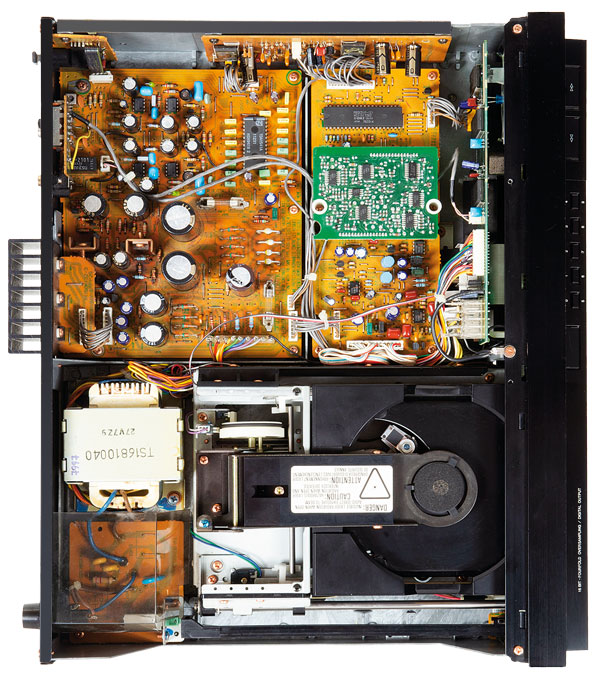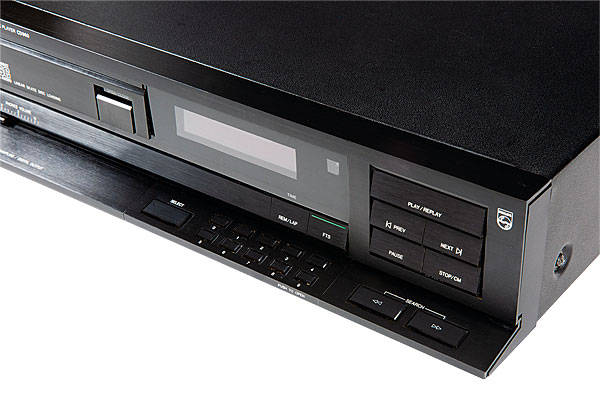Philips CD960 CD player Page 2
SL-P1200 [HFN Aug '13] respectively – which isn't something you could ever say about the CD650. And while clearly a product of the 1980s, it still looks attractive in a serious, functional way.
Logical Thinking
The way the drawer works eclipses any arrangement Philips had before (or would have again) and the way the whole player operates is simple and logical – never a certainty with Philips! The remote control handset is a stock (European) Philips part, which doesn't really complement the way the rest of the package is presented, but it works well enough and offers every function that you could possibly need.

As for the player's connections, these are the same as those you'd find on a player today, and include digital outputs in both coaxial and optical form. A separate DAC was made available in both the Philips and the Marantz ranges in 1988, but since it contains an identical circuit to the one employed in the CD960 itself its advantage is a dubious one.
![]() Tim Listens
Tim Listens
Given that the CD960 design represents a final polishing of the Philips 16x4 package rather than a total re-think, it comes as no surprise to find that the sound of this player is essentially familiar. This is no bad thing given that even the entry level CD160 was a very decent machine, and pretty much unbeatable at its price. It was just a bit rough around the edges for the most discerning listener.
Compared with the best of the older 14-bit Philips players – for example, the CD303 [HFN Nov '13] – the CD960 offers a drier take on the bass and has sharper, better focused treble. By any other standards this is still a rich-sounding machine, but those searching for the romantic, LP-like sound of the Philips first generation will not necessarily find it here.

One thing that does remain is the huge amount of space that Philips players traditionally generate in and around the music. The wilting late summer cool of Chris Rea's 'Miles Is A Cigarette', from his 1992 album Gods Great Banana Skin [East West 4509-90995-2], filled the space in my listening room when played on the CD960, complete with the trademark cymbals that shimmered and didn't splash – during the 1980s only Philips really knew how to do that. Compared to the tangled mess that many single-DAC Japanese players produce with this album, and others like it, the super-sized soundstage that the big Philips could render gives truth to the company slogan at the time: 'Simply years ahead'.
What really impresses about the CD960, though, is how it ensures that all the various parts of a musical performance meld together into a realistic whole. Many players don't do this so well and can sound forced and 'mechanical' as a result. To hear the Philips machine glide through a recital by The Dutch Swing College Band [PMF Records 90.794-2] is an utter delight.
 Yes, there isn't quite as much bass as the earlier Philips players would have been capable of delivering (even the first 16x4 ones), but the treble has been noticeably improved. The slightly pushed forward midrange is still in evidence, but it's now sufficiently smooth to no longer draw attention to itself. The result is that the album's opening piece 'Hello Mary Lou' is just so jaunty and brisk on the CD960 that it's hard to keep still as it plays. What's more, the brass and woodwind sections remain vivid yet the 'fingernails down a blackboard' harshness that some lesser players can give them is avoided.
Yes, there isn't quite as much bass as the earlier Philips players would have been capable of delivering (even the first 16x4 ones), but the treble has been noticeably improved. The slightly pushed forward midrange is still in evidence, but it's now sufficiently smooth to no longer draw attention to itself. The result is that the album's opening piece 'Hello Mary Lou' is just so jaunty and brisk on the CD960 that it's hard to keep still as it plays. What's more, the brass and woodwind sections remain vivid yet the 'fingernails down a blackboard' harshness that some lesser players can give them is avoided.
Top-End Polish
Complex, multi-layered mixes don't catch the CD960 out either. Dodgy's 'Staying Out For The Summer' [A&M 5810872] is separated cleanly into distinct instrumental sounds even as the track spans its noisy crescendo. Comfortable listening even at high volumes is another CD960 virtue; the top-end polish makes even this track's jangling, grinding guitars easy on the ear (and the tweeters!). Again, a little more bass would perhaps make this machine the perfect choice for rock music, but the extra amount required is so slight that it could easily be compensated for elsewhere in the system chain, by choice of matching amplifier or loudspeakers, or simply by pushing the speakers into the corners of the room.
Otherwise, I found my wish-list of sonic improvements to have been fulfilled – an unusual outcome when testing a product now over 30 years old. Just to confirm my findings, I directly compared the CD960 against my own Technics SL-P1200 and a borrowed Sony CDP-502ES. All audio equipment is a balance of different compromises and all these very fine players have their individual strengths. But as an overall package the CD960 was clearly the best. The SL-P1200 was a trifle coarse-sounding in comparison while the CDP-502ES was a bit bland.
Buying Secondhand
The use of the durable CDM1 mechanism means that the chances of finding a working CD960 today are good – contrast this with the top Sony machines of the era, which are now often sidelined due to worn-out optical assemblies. Many of the key ICs are also common to the rest of the Philips range, meaning in many cases replacement parts are not too difficult to find.

Without a doubt the most troublesome area is the player's tray mechanism, which uses four belts and two motors. Despite being thick and heavy the belts do not last long, the symptom being the inability of the machine to complete the loading cycle. Replacement kits are available but vary in quality, meaning that several may have to be tried to find a type which is suitable. Ensuring all the other parts in this complex arrangement slide and turn smoothly will lengthen the useful life of the new belts once installed.
Another fairly common problem is that the adhesive used to secure some of the components and wiring on the DAC PCB becomes corrosive with age, dissolving the track-work and damaging some smaller parts. The faults that result are often baffling, so it's a good idea to remove as much of this material as possible. Heavily rusted component leads found beneath the goo are often a pointer as to what has failed.
Finally, one often sees poorly implemented modifications in CD960s, often involving unsuitably large capacitors and the use of different op-amp chips in the analogue sections. Such things are best avoided. A few years ago these players could be had for pocket change, but not any more. Grown-up budgets are now required to secure a well cared for example.
Hi-Fi News Verdict
When this player was launched it was a range-topping machine and on hearing this sample it's easy to hear why. The CD960 remains a reference-class player of the highest quality, and even today is difficult to fault. Similar comments apply to the Marantz CD-94, which is the same machine inside. It's just a shame the Philips CD960 has become expensive again secondhand after years in the doldrums – start saving!


















































